Similar to canning peppers, canning fully fermented pickles is an excellent way to store them. No refrigeration is needed, and homemade canned dill pickles can be stored for at least a year in a cool, dark place. Remember though, pickles that will be canned need to be fermented in a 5% salt brine to be safe to eat. Stanley Marianski, a well-known guru of anything pickled, canned, smoked, or cured, in his book Sauerkraut, Kimchi, Pickles & Relishes suggests that pickles need to be brined in at least 5% salt brine to be safe for canning and storing un-refrigerated.
Fermented in a 5% salt brine for 3-4 weeks, the pickles come out full-sour and very, very tasty. Vinegar-pickled store-bought pickles can't compete with these morsels. If you like pickles, I highly recommend making these.
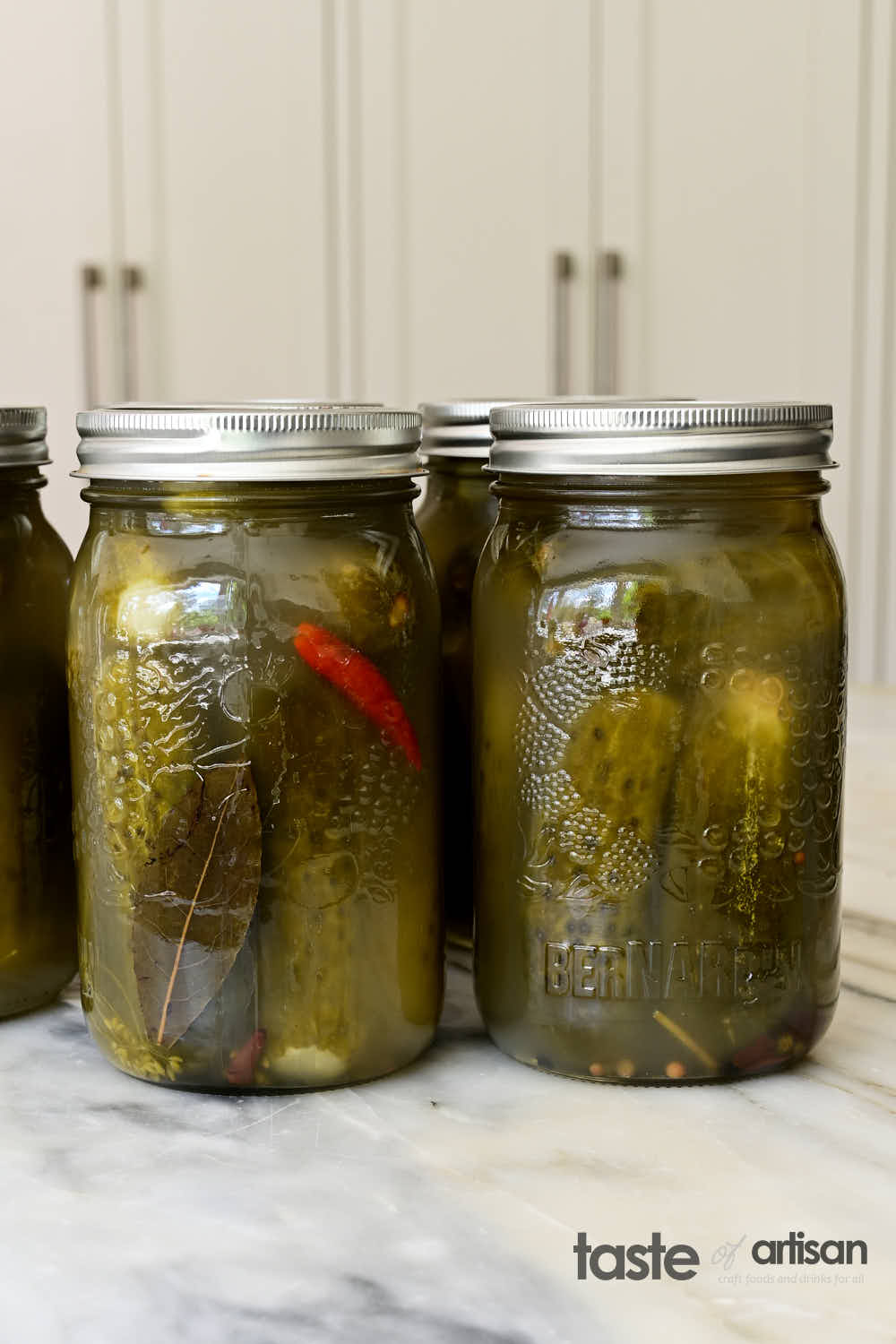
Proper fermentation tools
Another really important thing to remember when fermenting pickles for canning is to create an anaerobic environment. Fermentation will take about 3-4 weeks. Yeasts and molds are of aerobic nature and will thrive in the presence of air, producing a white slime on the surface. This slime must be removed on a daily basis, or else it will lead to the pickles becoming soft and losing their crunch.
Your brine will also get way more cloudy. As such, it's best to use a fermentation crock or a pot with a tight lid fitted with a fermentation airlock. It will make things easier for you and will require little tending during the fermentation process. All you need to do is remember to add water or salt brine to the airlock.
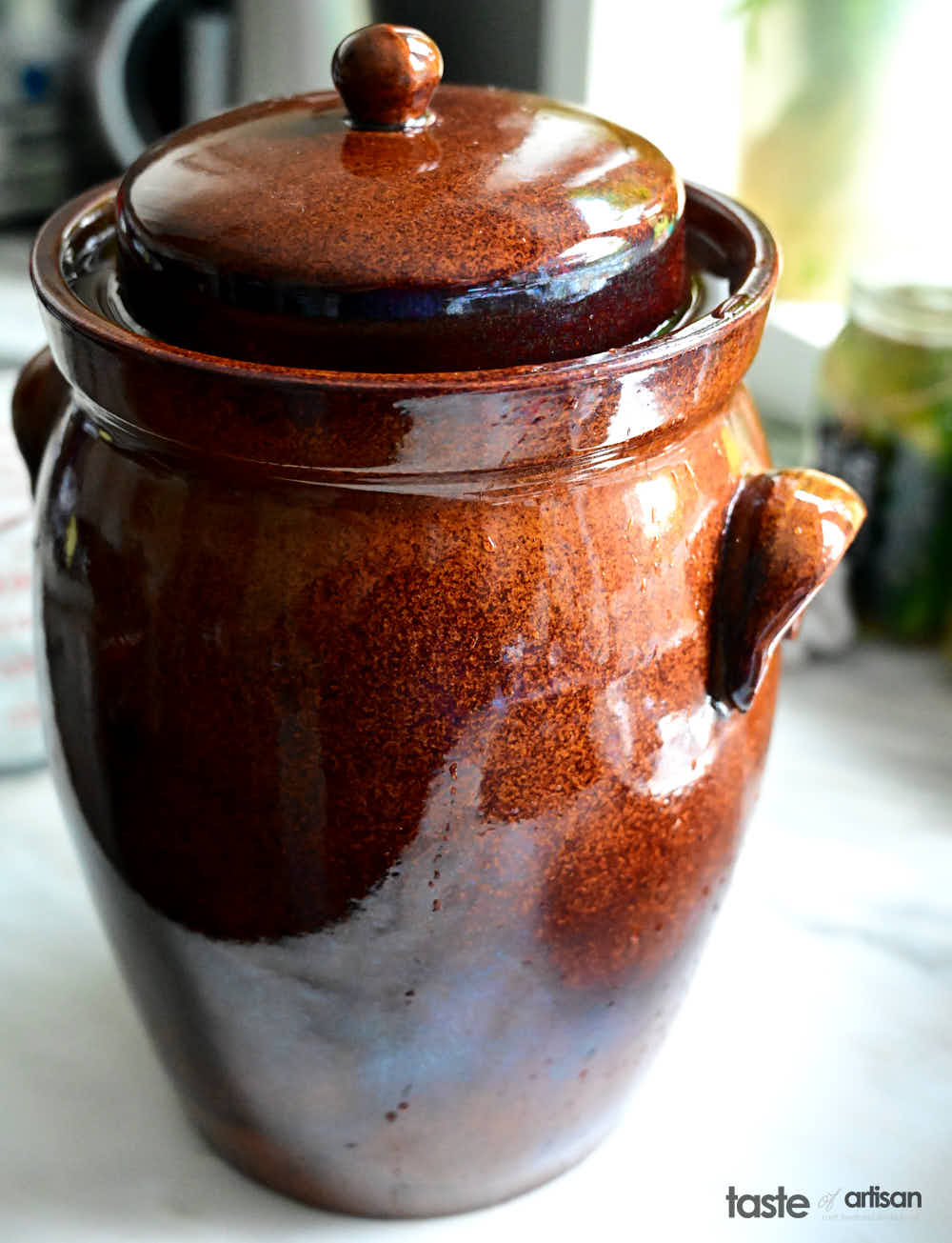
When using a fermentation crock, the brine comes out fairly clear, so I never feel like I need to filter it. There is also no slime formed on top due to lack of oxygen.
My fermentation crock is 1.9 gallons / 7 liters. It fits about 8.5 lbs of pickling cucumbers which is enough to make six 1-quart jars of fermented pickles.
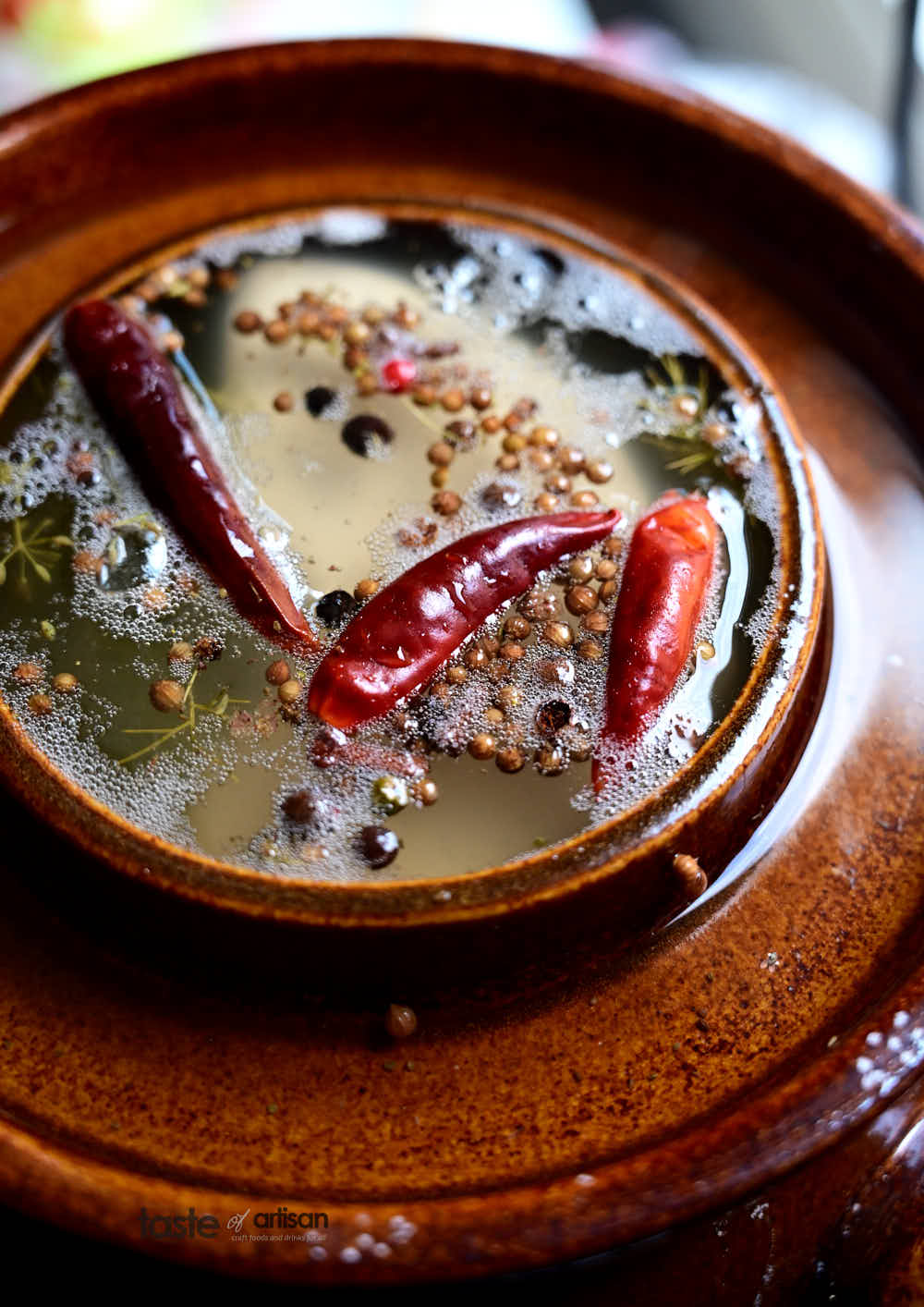
After processing in a canner, the brine clarifies even more, and the jars of pickles have a very nice visual appearance.
Fermentation time and temperature
Pickles that will be canned to be fully fermented. The lower the fermentation temperature, the longer they will take to ferment fully. It's recommended that you ferment pickles for canning at 64F to 72F for about 21-28 days, depending on the temperature, until the flesh of cucumbers turns translucent olive green. Pickles are fully fermented when you see no bubbles coming up to the surface. I usually ferment in my pantry at around 70F for 21 days and have always had excellent results.
Seasonings
I strongly believe that seasonings are very personal. I could use pickling spices, and many do with great results, but I prefer to add spices individually. This way, I have full control over the final flavor. Sometimes all it takes is one herb or spice to ruin the flavor, so keep that in mind when using spice mixes. In this recipe, I use garlic, pepper, cloves, mustard, dill, coriander, and allspice. I also add dried hot chili peppers for a tiny bite. You can barely feel it, but it makes pickles taste better. Feel free to use your own combination of spices or pickling spice mixes.
Keeping the pickles crunchy
Everyone likes their pickles crunchy. One sure way to make pickles lose their crunch is to leave blossoms on. The blossom area is where all sorts of tissue-softening enzymes live. If you want your pickles crunchy, cur those off really well.
Another way to preserve the crunch is to use firming additives such as horseradish root and oak or black currant leaves.
Soaking cucumbers in pickling lime prior to fermenting is another way to preserve the crunch.
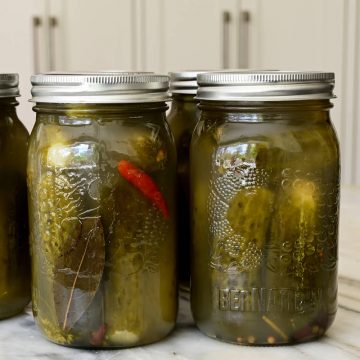
Canned Fermented Dill Pickles
Ingredients
- 8 1/2 lbs pickling cucumbers
- 1 gallon water 3,785 g; room temperature
- 2/3 cup pickling salt 189 g; kosher salt without additives will work as well
- 8 cloves garlic
- 4 inches horseradish root peeled and sliced or diced
- 6 dill umbrellas or 12-16 dill twigs
- 4 Tbsp peppercorns black or assorted pink, green, white and black
- 2 Tbsp coriander seeds
- 8 bay leaves
- 2 tsp mustard seeds
- 8 cloves whole
- 8 berries allspice whole
- 6 dried hot chili peppers whole
Instructions
- Wash the cucumbers but don't brush them off. Remove 1/16" off the blossom ends of the cucumbers.
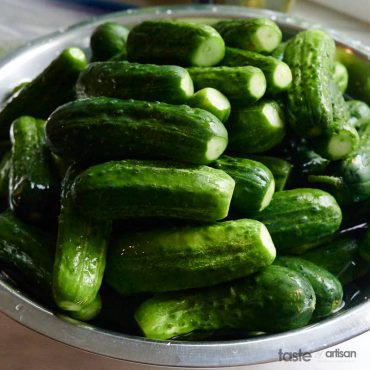
- Prepare a 5% salt brine by whisking the salt in the water until fully dissolved.
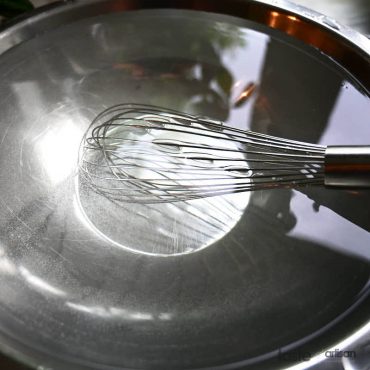
- Add half the seasonings to the bottom of the fermentation crock, followed by the cucumbers and the other half of the seasonings.
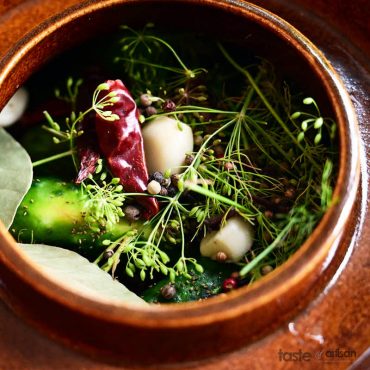
- Add enough brine to cover the cucumbers.
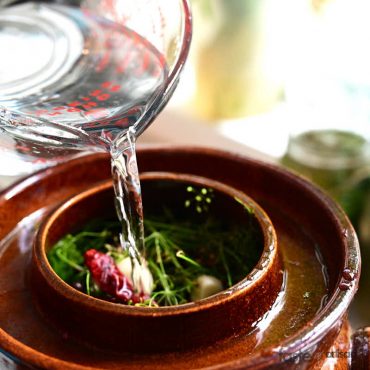
- Add a weight on top to keep the cucumbers submerged. For more details refer to the How to ferment dill pickles guide.
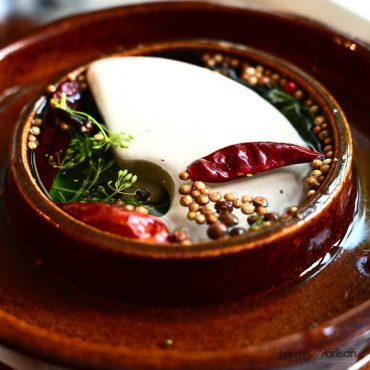
- Ferment the cucumbers at 64F - 72F for about 21-28 days (the higher the fermentation temperature, the faster the fermentation will be) until the flesh of the cucumbers turns translucent olive green.
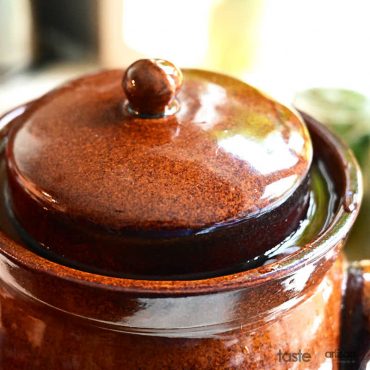
- When fermentation is done, carefully pour off the brine into a boiling pot, without disturbing the sediment and leaving it behind.
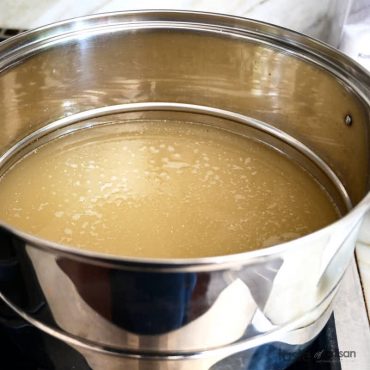
- Bring the brine to a boil, lower the heat and simmer for 5 minutes.
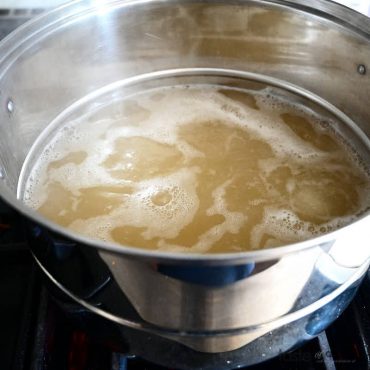
- Meanwhile, rinse the pickles and place them in sterilized 1-quart jars.
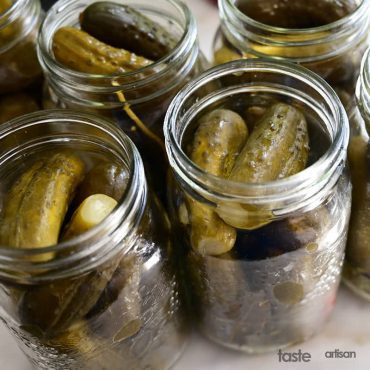
- You can also add the seasonings after giving them a quick rinse.
- Fill the jars with the hot brine leaving 1/2" headspace. Wipe the rims with a clean paper towel.
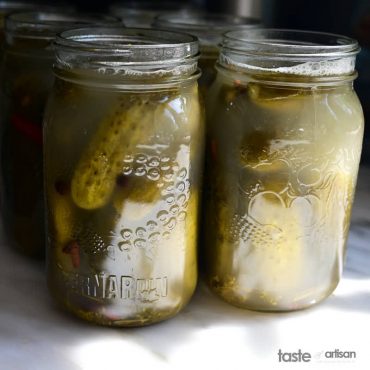
- Put sterilized lids on, tighten the bands finger-tight and process in a boiling water bath as follows: pints for 10, 15 and 20 minutes at 0-1,000, 1,001-6,000, and 6,001+ feet above sea level respectively, and quarts for 15, 20, 25 minutes at 0-1,000, 1,001-6,000, and 6,001+ feet above sea level respectively.
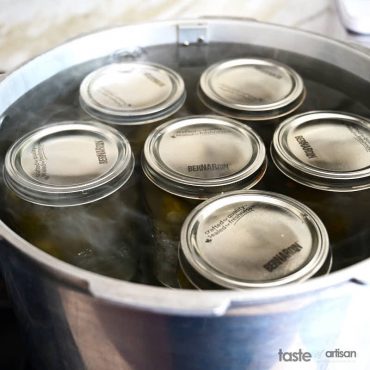
- Store in a cool, dry and dark place.
Notes
Nutrition


Jessica Karban says
Is it necessary to fully ferment the pickles before canning, or can you can partially fermented (half sour) pickles?
Victor @ Taste of Artisan says
If the are to be canned and stored unrefrigerated, yes, they must ferment fully to get the acidity to the safe level.
Steve says
Hi Victor, Have you had any experience with Masontops Pickle Pipes fermentation lids? The reason I ask is, as I mentioned in another comment, I put down several individual jars of both 5% and 3.5% dills. For two of the jars I used Ball fermentation lids and they turned out fine. For the other four jars I used the Pickle Pipe lids. In all four cases, a white coloured substance (mold, yeast?) formed on the surface of the brine even though the jars had never been opened during fermentation. Only one of the jars was what I would call bad. The others tasted fine after removing the substance.
Have you had any issues with these lids.
Victor @ Taste of Artisan says
Hi Steve, I haven't used either of those products, I use fermentation lids with traditional airlocks or just plain lids, which I lift just slightly to release excess CO2, or I use my fermentation crock. But it shouldn't matter as both of those products should do the job - which is keep air out and remove excess CO2.
The white scum forms when cucumbers are exposed to the air/oxygen and react with yeast and molds. This is ususally not a big deal if you remove it preriodically. But, ideally, you should keep cucumbers, herbs/leaves etc. fully submerged in brine and that should prevent scum from forming. I've had that happen to me before too, I just kept removing it every day until fermentation was done and it worked fine.
I did not have any scum forming this year and I didn't even use feremntation lids. I use these jars:
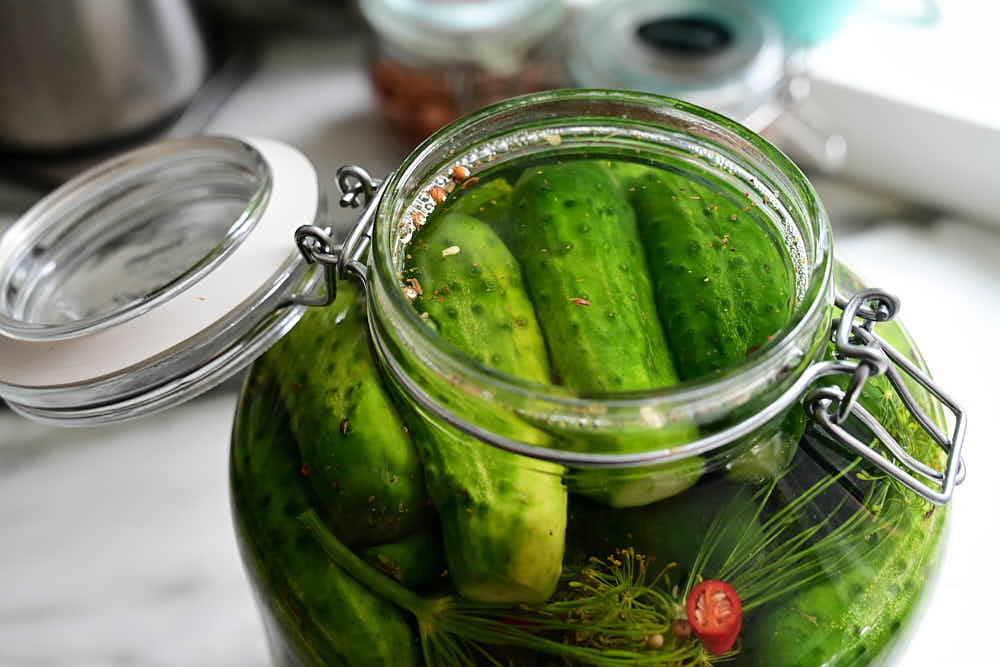
What I would do is open the lids just a little bit once a day to release excess CO2.
But what I did do differently this year is I added some brine from last year's fermented tomatoes, that's all (fermented) I had in the fridge from last season. I used about 1/4 cup per jar and that kick-started fermentation within the first day. Air is lighter than CO2 so when CO2 gets released, it pushes the air up and out when you open the lid. So, that worked well for me. Lesson learned - use a bit of starter to kick start fermentation which will push air out qiuckly and that will prevent any molds/yeast from interacting with it and forming scum on the surface. Hope this helps.
Steve E says
Canned the batch late last week. They turned out great. Perhaps a little more sour than last year. The pH was 2.9 after 28-days. I don't know what the pH was last year because I didn't have a meter. I should have started checking around the 21-day mark. I also tested my "distilled" water and for some reason it came in around 5 when it should have been 7. So that may also have had something to do with it. Was very surprised by the 5 reading and I tested more than once.
I also put down three individual quart jars with the 5% brine. I intend to let them go 28-days, but will start checking earlier. I did have a question, though. Once these jars are ready, can I go straight to canning without the rinsing and boiling? Ideally, I'd put them in the fridge, but I just don't have the room.
Someone on the other thread recommended the brine for a dirty martini. I tried it. It was awesome. I'm thinking next year I'll buy some gherkin sized cucumbers and do them as dills for use in martini's instead of olives.
Victor @ Taste of Artisan says
Hi Steve. Yeah, 5 for distilled water is way off. I would calibrate the meter.
I don't know the exact science behind boiling brines, but this follows the general USDA recommendation that, when canning fruit or vegetables in a boling bath canner, you need to bring the brine to a boil and boil for 5 minutes. I've seen many of their canning recipes and it's a standard recommendation.
Rinsing is also likely another safety precation whereby you remove most potential contaminants. I'd imagie some residual contaminants will be destroyed during canning but a large amount has a higher risk of some developing thermal resistance and surviing.
I know this saunds a little over the top compared to old-fashined recipes, but, hey, better be safe than sorry. Besides, some of my canned goods don't get consumed for 2-3 years and I like having confidence that they are perfectly safe to eat, even though some may lose their freshness, but usually even freshness doesn't noticeably deteriorate.
I bought a fridge for my basedment specifically for fermented fruit and veggies, I love them. I do both canning and fermentation for fridge storage. Both are great and very different. I can't go one year with my fermented pickles or apples:) or tomatoes.
Yeah, I've tried dirty martinii with my pickles too, loved it too.
Steve says
Thanks Victor. It was perplexing to get such a weird reading for distilled water, so I did some reading. Apparently it's not uncommon to get pH readings for distilled water between 5 and 7. I discovered that there are two reasons why this is possible.
First, distilled water has had almost all the ions usually found in water removed so that once it is exposed to the air, it reacts with the CO2 to form a weak acid, carbonic acid. The longer it is exposed to air the closer the reading can get to 5. I used water from a three-quarters empty jug so there was plenty of air in the bottle to lower the pH.
Second, because the water is deionized there aren't enough ions present in the water for the meter's pH electrode to function properly. As a result, it's tough to get a stable reading. It's suggested that you add salt KCl or NaCl to the water to get a more accurate reading. Adding the salt doesn't affect the pH.
I'm going to recalibrate the pH meter anyway and try it all over again. I did try the meter in a brand new bottle of water and got a reading of 6.3. I found this information on a UK blog called The Chemistry Blog.
Victor @ Taste of Artisan says
Interesting. I've learned something new. The easiest and most reliable way I know how to calibrate a pH meter - and I've accumulate 3 of them - is to use 4.1 and 7.1 buffer solutions. I use Hanna Instruments' buffer solutions. I don't know how calibration works with other pH meters, but the ones that I have ask for 4.1, then 7.1 and voila, done. It's easy and quick, and I do it every few months to be sure my meter is accurate.
Steve says
Hi Victor,
Put down my first batch of the year today. Hoping they turn out as great as last year's batch!
Also, does cuke size have any impact on fermentation time? A local farm has an excellent crop of small cukes which would make excellent baby dills.
Cheers.
Victor @ Taste of Artisan says
Hi Steve, it's that time of the year, LOL. Canning full steam over here. My understanding is that fermentation time is dependent primarily on the ambient temperature, not the size of the cucumbers. So, at say 72-75F, you will probably finish fermentation in less than three weeks, while at 65F it will take full 4 weeks. I would still stay at 3 weeks min to be on the safe side. Essentially, what fermentation is doing is it's dropping the pH of the brine to the safe-to-can level. If you have a reliable pH meter like Hanna Instruments, you can judge the status of fermentation by pH reading. I understand that pH of canned pickles is 3.2 - 3.5. So, I suppose when your pH drops to that level it would indicate completion of fermentation.
Anna C says
This is a great recipe! I have a question.
I am making several fermented foods because of some chronic health issues that I am fighting. My goal is to get the living probiotics, not just to preserve some yummy foods.
Because of that, I want to use this recipe (rather than your half-fermented refrigerated pickle recipe). But that also means that I don't want to can them (I don't want to boil the brine and heat the jars, because that would kill the bacteria).
So, could I use this recipe and then once fermentation is complete, transfer the jars to the fridge and eat it within a month or so?
Would I leave them in their brine? Should I leave the sedimentation in the bottom of the jars?
Or do I still need to rinse them and transfer them to new jars, with the brine (but without the sediment)?
Thanks!!
Anna
Victor @ Taste of Artisan says
Anna, by half-fermented you mean this fermented dill pickle recipe? This is not the same as my refrigerator pickle recipe, the veggies are fermented, I would say fully, though I ferment longer the ones that will be canned for safety reasons and for the reason that once thermally processed, they won't ferment any more, but in the fridge, they will, albeit slowly. If you intend on keeping them in the fridge, I'd use the recipe that I linked above as it has less salt, which I prefer, but is perfectly safe to keep in the fridge. You can fermented them longer if you want, but keep the salt at the same level. I bought a fridge last summer for my pickled veggies and I still have some fermented pickles from last summer, tomatoes and carrots and they are all great. I do not see any deterioration in taste or otherwise. The year before my pickles lasted 6 months until we ran out. Last year I made more. I canned some and refrigerated some. Here is a picture of my last pickle jar and one of the last refrigerated pickles.
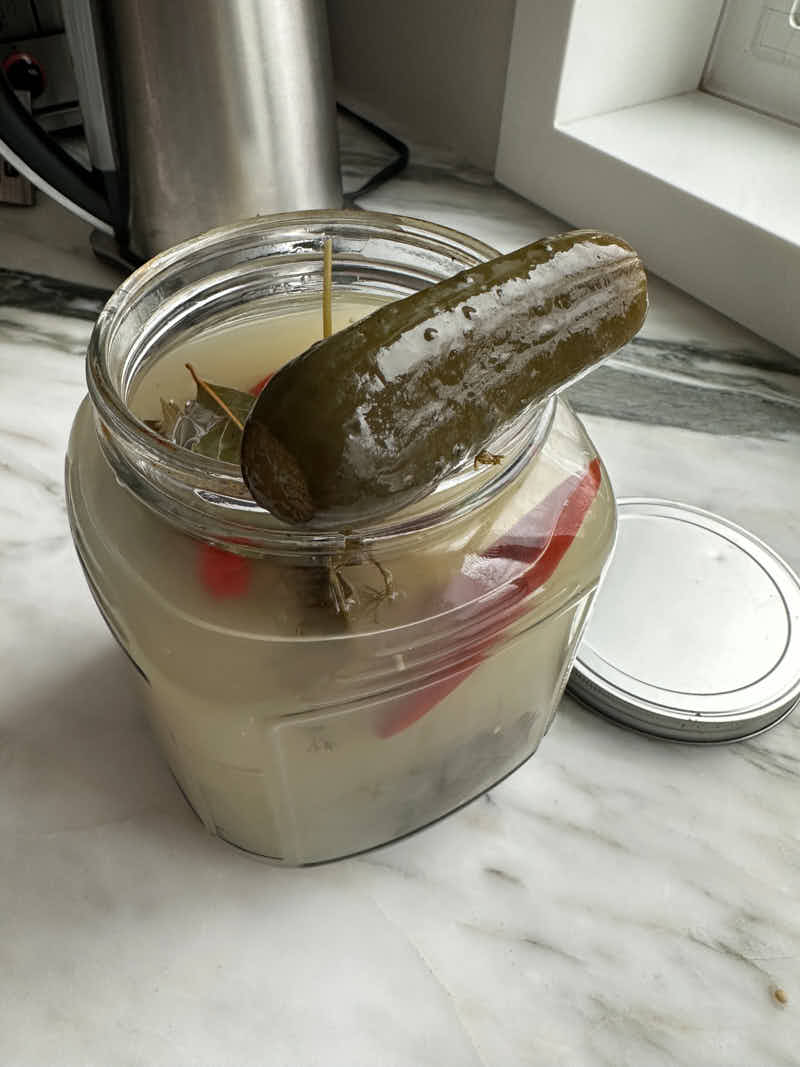
You must keep them in brine and refrigerated at all times. The sediment at the bottom - yeast - is totally fine. Do not rinse and transfer to new jars, it's not necessary. It's actually good. Despite the low temps in the fridge, I they continue to ferment, very slowly though. It's less noticeable with the pickles but I can definitely tell that my fermented tomatoes got quite a bit more acidic. Good luck!
Steve says
Hi Victor.
My batch was ready today. It turned out really well. Pickles had good crunch and colour plus great flavour. I canned them and they're cooling now. I got 6 quarts and 1 pint out of the batch. My plastic bucket with air lock worked great. They fermented 28 days as suggested. What would the result be if the fermentation period were shortened by a week?
I would definitely recommend this recipe .
Cheers,
Steve
Victor @ Taste of Artisan says
Hi Steve, glad to hear it. My family loved these pickles so much last year that they asked me to double the batch this summer, which I happily did. As far as fermentation goes, a typical fermentation can be completed in about 21 days if the pickles are to be canned. It depends on the ambient temperature and the starting quantity of lactic acid bacteria present. I suggest 28 days to be 100% sure but 21 days should be enough in most cases. If you add a tablespoon of brine with live starter culture, fermentation will start and complete faster. The higher the temperature (68F - 70F as opposed 64F - 65F), the faster fermentaiton will complete. The best way to tell is to measure the acidity of the brine, it should be about 3.2 - 3.5. If you have a pH meter, you can process them as soon as pH hits that level. Enjoy!
Steve says
Thanks Victor. I'll invest in a pH meter.
I sliced a bunch of the pickles up for burgers last night. I can't believe how crunchy they were, although the one's I sliced had gone straight into the fridge and weren't processed. I'm hoping the processed pickles retained their crunch too.
Next year I hope to have my own crop of cukes from the garden. I moved this year and wasn't able to grow any. In the past, I've had great results growing them from seed.
Cheers,
Steve
Victor @ Taste of Artisan says
Steve, they do lose a good amount of crunch during processing but we still like them a lot. If you want to preserve that crunch, just refrigerate. You don't need to ferment them in a 5% brine, you can do 3% (see my fermented pickles recipe). I made two large jars of fermented pickles this year that will stay in the fridge. Last year, we kept them in the fridge until New Years and they were perfect. So, as long as you have some fridge space, that's a good option. I bought a separate fridge for my basement mostly for fermented veggies and fresh fruit and vegetables.
Own cukes is a very good idea. So far, I couldn't find anything, even at farmer's markets, that would taste as good as the ones that I grew in my garden. Maybe it's the varieties. Maybe it's the freshness. Or both. Fresh off the vine, they are sweeter, crunchier, have a better texture, and so much tastier. My only problem this year has been cucumber beetles. I saw a couple last year, didn't really pay attention to them, all was good. This year, hundreds of them attacked all my plants and devastated them. I will have to take measures next year, which may not be easy as I have an organic garden.
Steve says
Victor, I'm regretting that I only made 6 jars worth. There's no way they'll last until cukes are available again. I split a jar with my son, who is away for college, and he's already gone through it and taken another full jar for himself. I was able to get a local farm's last two pounds of cukes so I'm making sour pickle chips for burgers hoping that will stretch out the full size sours a little longer. Agreed about fresh cukes. Sorry to hear about your infestation. I use the Square Foot Gardening method so if I get any serious pest problems, I can get rid of all my soil and start again the next season which usually guarantees that there are no eggs or larvae about. Thanks again for sharing your experience. It's greatly appreciated.
Victor @ Taste of Artisan says
Hi Steve, we had the same feeling last year and this year I doubled the amount of canned pickles and I also made two 5-qt jars of 3% refrigerator pickles. We are almost done one of those jars. The quality of my pickles is definitely better this year because I fermented them right away, the freshest they are the better. Another reason is that I added a whole bunch of black currant, oak and grape leaves so the pickles keep their crunch. I haven't tried my new canned pickles but my refrigerator picked are very crunchy. Yeah, I planted grapes and black currant just so I have leaves for making pickles;) Glad the oak tree was already there in my backyard or else I'd have to plant that one too;)
Steve says
I just prepared a batch today. While I'd really like to have a ceramic crock like you show in the post, or better yet, an oak barrel, I'm not ready to make that kind of an investment. I used a two gallon, food-grade plastic bucket and lid. I drilled a hole in the lid and fit it with a #6.5 bung and an S-shaped air lock purchased at a local home brew supplier. (All in it cost $10-Canadian). I bought 8.5 pounds of cukes and dill weed fresh from a local farm. I followed the recipe and have put the bucket aside to ferment. Oh, I wiped down the inside of the bucket and the lid with alcohol wipes before filling it with cukes and brine. I had some unused ceramic tiles laying around. I sanitized them in boiling water and used them to weigh down the cukes. I will add a comment after the fermentation period is over to let you know how they turned out.
The recipe prepares a gallon of salt brine, but later in the post under notes you say that the pickles ferment in about two quarts of brine. My bucket took almost the full gallon of brine.
Victor @ Taste of Artisan says
Steve, that reference in the notes I initially wrote for a smaller batch but forgot to adjust the amount of brine. It is indeed a gallon of brine. Thanks for pointing out, corrected.
There are lots of ways to do it. A fermentaiton crock is very convenient but you can easily make do with what you have on hand. A bucket will work. I was recently asked to make a second batch as my family loves these pickles so I had to quickly improvise. I used two spare large storage jars which I covered with silicone lids that my daughter uses for something. I had no idea how these lids would work but they worked perfectly. They create a tight seal and would inflate as CO2 is released and I would carefully release the pressure every couple of days. That kept mold spores and oxygen out and I got no slime or mold growing on top. No need for an air lock.
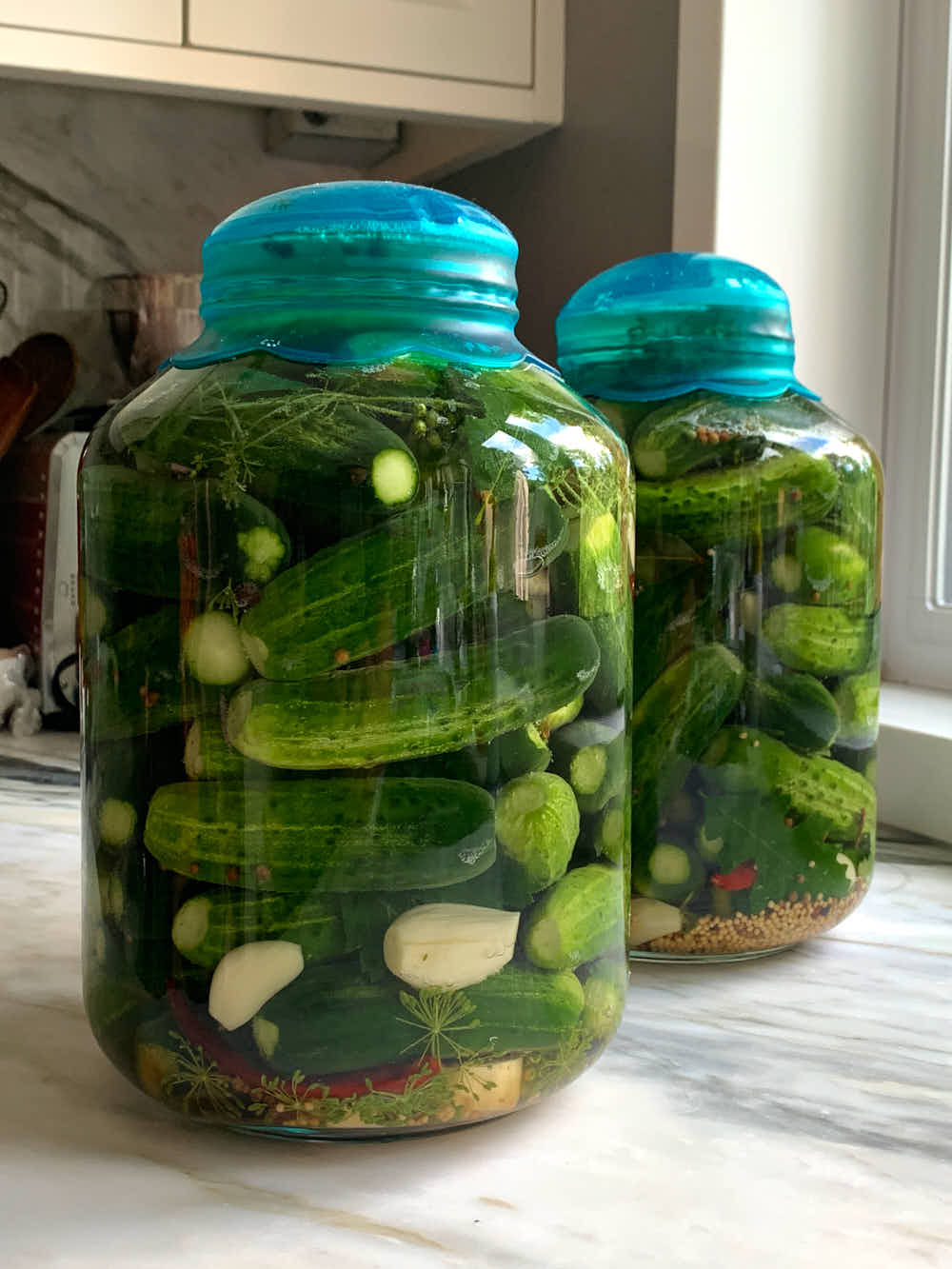
Steve says
Thanks Victor. My grandmother used to make kosher dills in the 60s and 70s. She had a beautiful 20 gallon ceramic crock that she used to make her pickles. It had no top, so she fashioned something out of wood, more to weigh things down than to act as a lid. Then she covered the whole thing in plastic. When fermentation was over, she jarred everything and stored it in her root cellar. It was more of an open fermentation and she would have to skim the crock every few days. I'm sorry now that I never took the time to learn her recipes and process. When you walked into the root cellar, it looked and smelled like pickle heaven. I lived next door to her for many years and would sneak into the cellar to steal a pickle or two. I often wonder what happened to that crock. I should also say she used it to ferment sour cherries from her orchard to make cherry wine. I've been told by one of my uncles that before I was born (pre-1960) she would distill it into cherry whisky.
I'm looking forward to seeing what comes of my current batch.
Victor @ Taste of Artisan says
I have similar memories. My great gradma and may grandparents used to make amazing things that I absolutely loved and I wish I had recipes for. I did repliacate a few things quite closely, like the smoked kielbasa that my grandpa used to make.
Good luck with your fermentation. It should turn out great. I made some low(er)-salt fermented pickles that we refrigerated and one batch of canned fermented pickles, and that wasn't enough, so I doubled the batches this year. My family loves them.
Vaso says
I feel sorry to bother you all the time ....I have another question... I read the link and I saw this:
" Yeast growth caused by under processing can also make pickling liquid pink, cloudy or slimy. Discard the pickles. Use the processing time and method recommended in the tested fresh preserving recipe"....
So, how could I know if there is any yeast growing? How can I be sure that there is no yeast growing?
If you have any time...when you have time, you might tell me...
Thank you!!
Vaso says
I saw mold on the upper part where there were exposed vegetables
Victor @ Taste of Artisan says
Vaso, it's hard to say without seeing exactly what you are talking about. I haven't seen this on my canned pickles. If you fermented your pickles properly and canned them properly you won't see any mold as all living organisms inside the can will be killed off. Sometimes insufficient processing can cause this, sometimes the seal breaks letting mold spores inside the can... did you see the mold right after opening the can or sometime after? Another thing is that what you see may be old deactivate yeast that looks like white residue... it's not mold. Bad mold is aggressive, fuzzy, blue, green, black or yellow... If you see those, discard the pickles. This may help.
Victor @ Taste of Artisan says
Hey Vaso, opened another jar of canned pickles last night and took a picture for you. Here is what mine looked like. Mind you, the top two pickles were not submerged in liquid.
https://tasteofartisan.com/wp-content/uploads/2022/03/pickles.jpg
Vaso says
Hello!! I did your recipe...but I left it for 6 weeks. A closed pot with an airflow. The taste and smell is very good. But I have a question. I noticed that cauliflowers had a slight pink colour, is this good or bad? I tasted a "pink" cauliflower and it was very good as taste, just as a pickle. But I am a little concered about the color. Thank you
Victor @ Taste of Artisan says
Good to hear it, Vaso. Glad you liked it.
As far as the cauliflower goes, the pink color is normal. This is due to a chemical reaction caused by the interaction of pickling liquid acid with the pigment of the cauliflower. Pink cauliflower is safe to eat. Enjoy!
Vaso says
Thank you!! I will sure enjoy it!!
Vaso says
Excellent recipe. May I ask, why should I wait for the fermentation to be completed and not proceed to canning immediately? Fermentation produces lactovacilus? Will they still be there after canning? Thank you!!!
Victor @ Taste of Artisan says
Hi Vaso,
It's done for safety reasons to prevent possible botulism poisoning. The most recent USDA recommendation is to can pickles in a boiling water bath as long as certain salt and acidity levels are achieved. Fermentation starts with Leuconostoc mesenteroides bacteria which is later taken over by Lactobacillus plantarum bacteria. They produce lactic acid which lowers the Ph of the brine. This takes time but also you need to give some time for the brine to penetrate inside the pickles. Once you process the can in a boiling water bath the acidity will remain but the lactic acid bacteria will be destroyed. There will be no further fermentation or increase in acidity.
If you want to preserve live bacterial cultures, it's best to ferment the pickles, cover with lids and refrigerate. These will last in the fridge for months. I still have a jar in my fridge I've been saving for the holidays since last July and they are delicious.
Vaso says
Thank you! Happy New Year!
Victor @ Taste of Artisan says
You are welcome. Happy New Year!